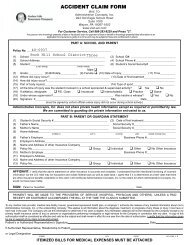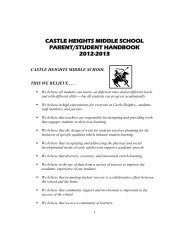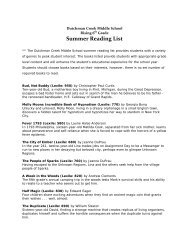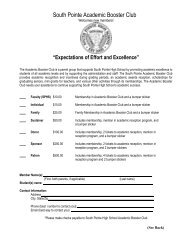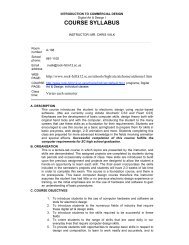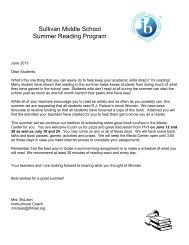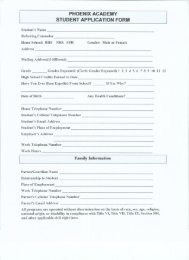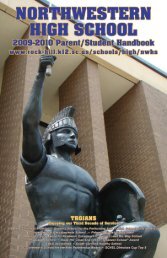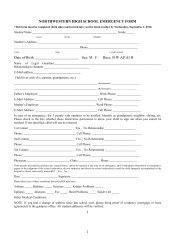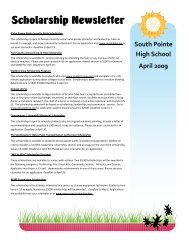Pharmacy Technician - Applied Technology Center
Pharmacy Technician - Applied Technology Center
Pharmacy Technician - Applied Technology Center
- No tags were found...
Create successful ePaper yourself
Turn your PDF publications into a flip-book with our unique Google optimized e-Paper software.
The <strong>Applied</strong> <strong>Technology</strong> <strong>Center</strong> offers authentically engaging career and technical education programs that<br />
provide all students the opportunity to acquire the skills, knowledge and motivation to achieve success<br />
in an ever changing world.<br />
<strong>Pharmacy</strong><br />
<strong>Technician</strong><br />
Syllabus<br />
School year<br />
2011-2012<br />
Lisa M. Carrigan, RN<br />
Instructor<br />
The ATC, where Academic Skills go to Work! 1
The <strong>Applied</strong> <strong>Technology</strong> <strong>Center</strong> offers authentically engaging career and technical education programs that<br />
provide all students the opportunity to acquire the skills, knowledge and motivation to achieve success<br />
in an ever changing world.<br />
PHARMACY TECHNOLOGY<br />
ACTIVITY/COURSE CODE: 5570<br />
COURSE DESCRIPTION:<br />
<strong>Pharmacy</strong> <strong>Technology</strong> is designed to train pharmacy technicians to pass the <strong>Pharmacy</strong> <strong>Technician</strong><br />
Certifying Board examination. A practicing pharmacist has developed the curriculum. The program includes<br />
90 classroom hours plus 60 homework hours for a total of 150 hours. The American Council of<br />
Pharmaceutical Education accredits the program.<br />
The CD-ROM format serves as the students’ text and workbook. The interactive multimedia training uses<br />
Internet access, on-line testing, scoring, and monitoring. Teachers can monitor students’ progress via<br />
Internet. Students work at their own pace and teachers determine when exams are taken. The cost of the<br />
CD for the students is $255 each. The course is as a stand-alone course and an independent study. More<br />
information can be found at www.passassured.com<br />
GENERAL REQUIREMENTS:<br />
This course is recommended for students in grade 12 who are scheduled to graduate at the conclusion of<br />
the year in which training is begun. Eligibility to register for the <strong>Pharmacy</strong> <strong>Technician</strong> Certifying Board<br />
examination requires a high school diploma.<br />
CREDIT:<br />
1 unit high school credit<br />
RESOURCES:<br />
COURSE OVERVIEW: This course is a self-paced course delivered through the use of varied computerbased<br />
technologies and project-based assignments.<br />
The ATC, where Academic Skills go to Work! 2
The <strong>Applied</strong> <strong>Technology</strong> <strong>Center</strong> offers authentically engaging career and technical education programs that<br />
provide all students the opportunity to acquire the skills, knowledge and motivation to achieve success<br />
in an ever changing world.<br />
COURSE COMPETENCIES<br />
STANDARD 1<br />
ORIENTATION<br />
In the Orientation section, students are introduced to basic terms and definitions, the <strong>Pharmacy</strong> <strong>Technician</strong><br />
Certification Board (PTCB), and the PTCB exam. PTCB recertification details and easy-to-follow steps for<br />
maintaining certification are provided. Each subsection is supplemented with a Windows help file accessible<br />
at any time from the CD Drive.<br />
<br />
<br />
<br />
<br />
<br />
Certification, Licensure, and Registration<br />
Review of important basic terms and definitions.<br />
The PTCB and the Certification Exam<br />
Review of the <strong>Pharmacy</strong> <strong>Technician</strong> Certification Board, its founding members, and purpose.<br />
The PTCB certification examination structure, time allowed for exam, and broad topic content is<br />
also included.<br />
Recertification<br />
Details the processes needed to maintain certification.<br />
Contact information and requirements for recertification are provided.<br />
FEDERAL LAW<br />
From Food and Drug Administration laws to the Poison Prevention Act, federal laws that have guided<br />
pharmacy are presented. In this section, the method used to determine a valid DEA number is reviewed.<br />
Because state and local laws vary greatly, it is not practical for this product to cover them. The PTCB exam<br />
covers only federal law.<br />
<br />
<br />
<br />
<br />
<br />
<br />
<br />
<br />
<strong>Pharmacy</strong> Law and Time<br />
Review of laws that affect the pharmacy industry, when they were enacted, and their importance.<br />
Federal Law and Drugs<br />
Evaluation of the Controlled Substance Act of 1970, which regulates the manufacture, distribution,<br />
and dispensing of controlled substances based on abuse potential.<br />
Rules for Controlled Substance Prescriptions<br />
Outlines filing procedures and record maintenance in accordance with state and federal laws.<br />
Also covers drug substitution requirements.<br />
DEA Number Verification<br />
Review of how a doctor's DEA number is determined and its purpose.<br />
An interactive display gives the student instructions on how to determine if a DEA number is valid.<br />
Schedule II Drugs<br />
Review of storage requirements for Schedule II Drugs.<br />
Investigational Drugs<br />
Explanation of the four phases of investigational drugs.<br />
The ATC, where Academic Skills go to Work! 3
The <strong>Applied</strong> <strong>Technology</strong> <strong>Center</strong> offers authentically engaging career and technical education programs that<br />
provide all students the opportunity to acquire the skills, knowledge and motivation to achieve success<br />
in an ever changing world.<br />
STANDARD 2<br />
MEDICATION REVIEW<br />
In this section, the pharmacy technician is introduced to pharmacology. The study guide focuses<br />
on maintaining the proper instructional level for a pharmacy technician. Various types of drugs,<br />
prescriptions, medication dosage forms, and medical devices are reviewed. Drug interactions in<br />
the human body's major systems, such as the central nervous system, peripheral nervous<br />
system, and cardiovascular system are evaluated. The study concentrates on commonly used<br />
drug classes that would be of most concern for the <strong>Pharmacy</strong> <strong>Technician</strong>.<br />
<br />
<br />
<br />
<br />
<br />
<br />
<br />
<br />
<br />
<br />
<br />
<br />
<br />
<br />
<br />
<br />
<br />
<br />
<br />
<br />
<br />
<br />
Doses and Terminology<br />
Review of pharmacology terms.<br />
In-depth review of various types of medication dosages, such as tablets, caplets, liquids,<br />
creams, emulsions, etc.<br />
Description of various administration devices for certain medications and dosages.<br />
Central Nervous System<br />
Medication review of drugs that affect the central nervous system (CNS).<br />
Includes drug interactions and the mechanism of action.<br />
Components of the CNS are briefly covered.<br />
Peripheral Nervous System<br />
Medication review of drugs that affect the peripheral nervous system (PNS).<br />
Includes drug interactions, mechanism of action, and manufacturer-named drugs.<br />
Components of the PNS are briefly covered.<br />
Hormones<br />
Medication review of hormonal drugs, which are classified as those that significantly influence<br />
emotions and quality of life.<br />
Includes drug interactions, mechanism of action, and manufacturer-named drugs.<br />
Local and systemic hormone uses are studied.<br />
All male and female hormones are reviewed.<br />
Cardiovascular Drugs<br />
Medication review of drugs that affect the cardiovascular system.<br />
Includes basic terms & definitions, drug interactions, mechanism of action and manufacturer named<br />
drugs.<br />
Components of the cardiovascular system are briefly presented.<br />
Renal Drugs<br />
Medication review of drugs that affect the renal system.<br />
Includes basic definitions, drug interactions, mechanism of action, and manufacturer-named drugs.<br />
Components of the renal system are briefly presented.<br />
Anti-Infectant Drugs<br />
Medication review of drugs classified as anti-infectants.<br />
Includes drug interactions, mechanism of action, manufacturer-named drugs, anti-infectant drug<br />
classes and typical treatment regimes.<br />
Therapeutic classes used in the treatment of infections are reviewed.<br />
The ATC, where Academic Skills go to Work! 4
The <strong>Applied</strong> <strong>Technology</strong> <strong>Center</strong> offers authentically engaging career and technical education programs that<br />
provide all students the opportunity to acquire the skills, knowledge and motivation to achieve success<br />
in an ever changing world.<br />
<br />
<br />
<br />
<br />
<br />
<br />
<br />
<br />
<br />
<br />
Cancer Chemotherapy Drugs<br />
Medication review of chemotherapy drugs.<br />
Includes drug interactions, mechanism of action, and manufacturer named drugs.<br />
Therapeutic classes used in the treatment of cancer are detailed.<br />
Personnel safety and safe handling procedures for these dangerous agents are presented.<br />
Blood and Blood Formation<br />
Medication review of blood and blood formation drugs.<br />
Includes drug interactions, mechanism of action, and manufacturer-named drugs.<br />
Basic definition referencing to blood and blood formation abnormalities are detailed.<br />
Vitamins<br />
A medication review of vitamins.<br />
Includes drug interactions, mechanism of action, and manufacturer-named drugs.<br />
An illustrated study aid helps students remember which vitamins are fat-soluble and which are<br />
water-soluble.<br />
STANDARD 3<br />
ASEPTIC TECHNIQUES<br />
In this section, students briefly review preparation procedures for parenteral products. Pictures taken during<br />
the preparation of different sterile products are used to illustrate various topics. Laminar and horizontal<br />
airflow hoods are explained through the use of pictures and diagrams. Devices used in the preparation of<br />
sterile products are illustrated. Students will learn the basics of aseptic techniques with emphasis on<br />
possible testing topics.<br />
<br />
<br />
<br />
<br />
<br />
<br />
<br />
<br />
<br />
<br />
<br />
<br />
<br />
<br />
Definitions<br />
The definitions module explores basic terminology and environmental contamination concerns in<br />
performing aseptic techniques procedures.<br />
Laminar airflow hoods, air filtration systems, and inspection requirements are highlighted<br />
Vertical airflow hoods and biological safety cabinets are reviewed.<br />
Syringes<br />
The components of a syringe are illustrated and reviewed.<br />
Various types of syringes are graphically illustrated.<br />
The components of needle assembly and how the size (gauge) of a needle is determined are<br />
graphically illustrated.<br />
Parenteral<br />
A high-level review of various injection types.<br />
Includes uses of parenteral routes and the four most widely used parenteral routes.<br />
Intravenous injection types and widely used parenteral fluids are illustrated.<br />
This module prepares the student for review of sterile compounding.<br />
Techniques of Sterile Compounding<br />
Broad overview of skills needed to perform sterile compounding.<br />
Tips for avoiding contamination while using a Laminar airflow hood, and various procedures that<br />
assure successful sterile product mixing are provided.<br />
Examples include filling a syringe, breaking an ampule, reconstituting a sterile powder, injecting<br />
liquids into a plastic IV bag,<br />
Introducing liquids into a glass intravenous bottle, and many more necessary aseptic techniques.<br />
The ATC, where Academic Skills go to Work! 5
The <strong>Applied</strong> <strong>Technology</strong> <strong>Center</strong> offers authentically engaging career and technical education programs that<br />
provide all students the opportunity to acquire the skills, knowledge and motivation to achieve success<br />
in an ever changing world.<br />
<br />
<br />
<br />
Solutions<br />
Irrigation solutions, parenteral solutions, and TPNs are highlighted.<br />
Parenteral Antineoplastic Agents<br />
A general overview of preparation and the safe handling of antineoplastic agents used in the<br />
treatment of cancer. Emphasis on employee safety and safe procedures for handling these<br />
dangerous agents.<br />
Stability Considerations for Parenteral Products<br />
Parenteral Products have special stability concerns; information on various types of reference<br />
materials is included in this section. The steps of a Parenteral Admixture Order are illustrated.<br />
Details steps from receiving the order to delivering to the patient.<br />
STANDARD 4<br />
CALCULATIONS<br />
<strong>Pharmacy</strong> calculations are an essential function of the pharmacy technician. The PTTP's calculation section<br />
provides a refresher path through aspects of pharmacy mathematics. Many examples are calculated using<br />
different methods, providing the student a choice for calculating pharmacy math problems that best suits his<br />
or her needs. Calculations are performed actively with a timed audio presentation.<br />
<br />
<br />
<br />
<br />
<br />
<br />
<br />
<br />
<br />
<br />
<br />
<br />
<br />
Metric Measurements<br />
Audio, charts, graphic illustrations, and text help files are provide the student with knowledge and<br />
reference tables for use in performing various conversions.<br />
Units of measurement in the Metric, Avoirdupois, and Apothecary systems are reviewed.<br />
Abbreviations<br />
The pharmacy industry exists in a world of abbreviations.<br />
Abbreviations used in prescriptions are reviewed in detail, with emphasis on abbreviations that are<br />
often misinterpreted.<br />
Reference listing of pharmacy abbreviations is included.<br />
Roman Numerals<br />
The eight primary roman numerals are illustrated, with emphasis on rules for adding and<br />
subtracting<br />
Roman numerals are widely used in pharmacy.<br />
Fractions, Decimals, & Percentages<br />
In this section, basic fraction, decimal, and percentage calculations are reviewed.<br />
The intensive use of 'motion graphics' supports the audio-driven lesson.<br />
A thorough understanding of this content will give the student a basis for mastering the remaining<br />
calculations topics.<br />
Temperature Conversions<br />
Two widely used methods for temperature conversions between Fahrenheit to Centigrade are<br />
illustrated.<br />
The audio-driven lesson uses 'graphics in motion' to provide clear examples of typical pharmacy<br />
temperature conversions.<br />
Ratios<br />
In the pharmaceutical field, ratios are used to provide a means for reducing or enlarging chemical<br />
mixtures.<br />
The ATC, where Academic Skills go to Work! 6
The <strong>Applied</strong> <strong>Technology</strong> <strong>Center</strong> offers authentically engaging career and technical education programs that<br />
provide all students the opportunity to acquire the skills, knowledge and motivation to achieve success<br />
in an ever changing world.<br />
<br />
<br />
<br />
<br />
<br />
<br />
<br />
<br />
<br />
<br />
Procedures for determining the proper amount of solution to mix with drug active ingredient(s) are<br />
detailed.<br />
Quantities, Dilutions, and Concentrations<br />
A review of measurement for drug and expressions of quantity and concentration for drug products.<br />
Illustrates methods of determining quantities of ingredients and concentrations of drugs when<br />
preparing or dispensing drug products.<br />
Dosage Regimen<br />
Methods of expressing doses and dosage regimens.<br />
Students will learn to calculate the amount of drug product to dispense, or the number of days'<br />
supply from a dosage regimen.<br />
Emphasizes learning methods to calculate doses for pediatric patients.<br />
IV Flow Rates<br />
The student will learn to determine the flow rate of an IV solution when given the total volume, total<br />
time of administration, and the drops delivered per ml.<br />
Powder Volumes<br />
How to calculate powder volume and use this information in reconstituting dry powders for<br />
suspension or solution.<br />
Pricing<br />
Pricing methods support the needs of the pharmacy as a business enterprise.<br />
PTTP’s study guide will provide a review of various pricing methods used in retail pharmacy.<br />
STANDARD 5<br />
PHARMACY OPERATIONS<br />
<strong>Pharmacy</strong> operations are at the core of the pharmacy technician’s responsibilities. This section covers dayto-day<br />
operations; interactions with customers; patient records maintenance; inventory controls<br />
management; and state, federal, and local requirements. The program includes an overview of insurance<br />
claims and third party reimbursement.<br />
<br />
<br />
<br />
<br />
<br />
<br />
<br />
<br />
<br />
<br />
Basic Facts<br />
The pharmacy technician will need to be familiar with drug nomenclature.<br />
The three names given to each drug are reviewed.<br />
NDC codes, mnemonic codes, and the importance of understanding different expiration date<br />
formats are discussed and illustrated.<br />
Various drug containers are illustrated.<br />
The different types of container closures and uses for each are reviewed.<br />
Assisting the Pharmacist<br />
Outlines acceptable medication prescribers, how prescriptions can be transmitted to a pharmacy,<br />
and specific requirements for certain classes of drugs.<br />
Outlines required information for prescription and the process for patient refills is given.<br />
General Prescription Duties<br />
Maintaining an accurate patient profile is crucial in providing medication to a patient.<br />
A well-maintained patient profile can prevent improper dispensing of medication and adverse<br />
effects for medication.<br />
Details of what should be collected for a proper patient profile are illustrated.<br />
The ATC, where Academic Skills go to Work! 7
The <strong>Applied</strong> <strong>Technology</strong> <strong>Center</strong> offers authentically engaging career and technical education programs that<br />
provide all students the opportunity to acquire the skills, knowledge and motivation to achieve success<br />
in an ever changing world.<br />
<br />
<br />
<br />
<br />
<br />
<br />
<br />
Formularies, measuring and counting techniques, compounding and the different classes of<br />
balances are discussed.<br />
Medication Distribution and Inventory Control<br />
Definitions of key terms used in inventory management are provided.<br />
Ordering techniques and the proper receiving process of ordered items is reviewed.<br />
Expired or discontinued stock processes and drug recall issues are illustrated.<br />
Third Party Reimbursement<br />
Knowledge of "Third Party" reimbursement is an ever-changing environment.<br />
A general overview of processes used for reimbursement and different payment plans currently<br />
offered is illustrated.<br />
Formularies and generics are reviewed.<br />
Grading Scale<br />
A - 100 – 93<br />
B - 92 – 85<br />
C - 84 – 77<br />
D - 76 – 70<br />
F - 69 – 0<br />
Each section of the curriculum contains quizzes and a section test. The section tests will be<br />
required to be completed multiple times. The questions from the section tests are obtained from a<br />
large database of questions. Students will see different questions each time he/she takes the<br />
test. Repeated testing allows the student to see more and more questions. This helps to provide<br />
the student with great exposure to possible questions on the PTCB (<strong>Pharmacy</strong> <strong>Technician</strong><br />
Certification Board) test. Repeated testing also ensures mastery of the concepts.<br />
Section Tests/Projects: 80%<br />
Final Exam: 20% of the final grade<br />
For example: [ { 1 st term * 2 }+ {2 nd term * 2}+ Final exam ]/5 = Final grade<br />
[85+85+92+92+87]/5 = 88.2<br />
All students are responsible for attaining course competencies by completing the following requirements:<br />
1. Use of computer program, the section quizzes, section tests, tutored exam and final exam<br />
2. Complete assigned projects/homework/class work.<br />
Costs Involved in <strong>Pharmacy</strong> <strong>Technology</strong><br />
Purchase of PassAssured CD - $255.00<br />
Notebook/Binder and paper<br />
Fees associated with taking PTCB (see www.PTCB.org)<br />
Course Requirements<br />
Students are responsible for attaining competencies through completion of the following course<br />
requirements:<br />
1. Attendance (as per District #3 policy)<br />
a. This is an online course with independent student unless the student is scheduled to be<br />
present at ATC for class (varies with each student).<br />
b. Attendance is not kept.<br />
2. Participation in on-line curriculum and assessment<br />
3. Completion of section quizzes, tests and exams<br />
4. Completion of any assigned individual projects<br />
5. Maintenance of Academic Honesty (Any student caught cheating or involved in any other academic<br />
dishonesty will be given a grade of zero and will be subject to further disciplinary action.)<br />
The ATC, where Academic Skills go to Work! 8
The <strong>Applied</strong> <strong>Technology</strong> <strong>Center</strong> offers authentically engaging career and technical education programs that<br />
provide all students the opportunity to acquire the skills, knowledge and motivation to achieve success<br />
in an ever changing world.<br />
Projects/Internet Research/Exam<br />
Projects will be assigned related to research in <strong>Pharmacy</strong> <strong>Technology</strong>. Due dates will be established.<br />
Students must complete all required assignments by the designated due dates, with particular attention paid<br />
to the end dates of terms. Once terms have ended, students will not be allowed to submit work for the<br />
assignments during that term.<br />
Final Exam will be comprehensive and will include knowledge and application questions.<br />
Required Supplies<br />
1. 3-ring binder<br />
2. Paper<br />
3. Blue or black pen or pencil (no red, green, yellow, etc. pens to be used for assignments except as<br />
appropriate for projects).<br />
4. Computer headphones<br />
5. PassAssured CD<br />
Emergency Procedures<br />
Emergency evacuation procedures are posted in the classroom near the entrance door. Fire extinguishers<br />
are located near the exit.<br />
Classroom Rules (If assigned to attend ATC)<br />
1. Participate in classroom activities.<br />
2. Class lab time is expected to be spent in lab work and projects. This is not free time. Attendance<br />
and concerted work effort on assignments are required. Work at home will be required in addition<br />
to work during lab time (work at home should not substitute for work during lab periods).<br />
3. Internet usage is limited to classroom assignments. Any other use must be approved in advance by<br />
the instructor.<br />
4. Cell phones, iPods and MP3 players may be used inside the class. The <strong>Applied</strong> <strong>Technology</strong> <strong>Center</strong><br />
is not responsible for electronic devices brought to ATC and lost or stolen.<br />
5. Food and beverages at not permitted in the classroom. This includes plate lunches, drinks, candy,<br />
etc. whether open or not.<br />
6. Maintain all your hard copies within your own 3-ring binder. You are responsible for submitting all<br />
work in the appropriate box and retaining any returned work should it be necessary to validate<br />
completion of your work. The instructor will not be responsible for storing student work.<br />
7. Your ideas, comments, suggestions, questions, grade challenges, etc. are welcome. Your<br />
discretion in these matters is expected. These matters should be addressed in a respectful, mature<br />
manner.<br />
8. Be present and on time, prepared each day to gain as much knowledge as you possibly can.<br />
Finally…..<br />
For most students this will not be a difficult course. It will require diligence and hard work on your part. It will<br />
require time management and self-motivation as most of this course will be self-directed. The instructor will<br />
act as a facilitator and resource. Students will be expected to complete all work assigned and plan their time<br />
accordingly. Your success in this course will greatly depend on your efforts.<br />
I wish you much success!!<br />
Lisa Carrigan, RN, Instructor – Health Science (<strong>Pharmacy</strong> <strong>Technology</strong>, Medical Terminology, Patient Care<br />
Relations)<br />
The ATC, where Academic Skills go to Work! 9
The <strong>Applied</strong> <strong>Technology</strong> <strong>Center</strong> offers authentically engaging career and technical education programs that<br />
provide all students the opportunity to acquire the skills, knowledge and motivation to achieve success<br />
in an ever changing world.<br />
STUDENT INFORMATION<br />
<strong>Pharmacy</strong> <strong>Technology</strong><br />
Full Name _________________________________ Age ______ Date of Birth _____________<br />
Address ___________________________________ Home Phone ______________________<br />
City, State, Zip _______________________________________________________________<br />
Email Address _______________________________________________________________<br />
Home School __________________ Grade __________ Homeroom Teacher _____________<br />
Career Objective ______________________________________________________________<br />
Computer Experience __________________________________________________________<br />
Parent/Guardian Name _________________________________ Relationship _____________<br />
Parent/Guardian Work Phone __________________ Place of Business ___________________<br />
Parent/Guardian Email Address ___________________________________________________<br />
Emergency Phone # _________________________ Cell Phone ________________________<br />
Statement of Responsibility:<br />
As a student in <strong>Pharmacy</strong> <strong>Technology</strong> at <strong>Applied</strong> <strong>Technology</strong> <strong>Center</strong>, I understand that I am responsible for<br />
maintaining the integrity of all the equipment and software in this class. I understand that any damaged<br />
equipment/software that results from improper handling, negligence or other inappropriate behavior will be<br />
replaced at my expense. I also understand that inappropriate use of the Internet may result in loss of use<br />
privileges. This includes, but is not limited to unauthorized downloading of software, configuration changes,<br />
use of chat lines, violation of copyright laws and other misuse of school computers and Internet.<br />
______________________________________<br />
Student Signature<br />
______________________________________<br />
Parent/Guardian Signature<br />
Date<br />
Date<br />
____________________________<br />
____________________________<br />
*Passwords and usernames will be chosen by the student but will be made available to instructor and<br />
parent/guardian.<br />
The ATC, where Academic Skills go to Work! 10



